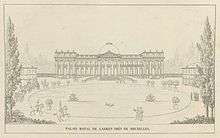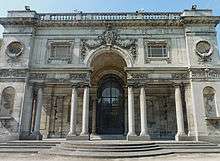Royal Palace of Laeken
| Royal Palace of Laeken | |
|---|---|
|
Kasteel van Laken (Dutch) Château de Laeken (French) Schloss Laken (German) | |
|
Main façade of the Royal Palace of Laeken | |
| General information | |
| Town or city | Laeken (Brussels) |
| Country | Belgium |
| Construction started | 1782 |
| Client | Governors of the Habsburg Netherlands, Archduchess Maria Christina of Austria and her husband Albert of Saxe-Teschen |
| Owner | Monarchy of Belgium |
| Design and construction | |
| Architect | Charles de Wailly |
| Engineer | Louis Montoyer |
The Royal Palace of Laeken or Royal Castle of Laeken (Dutch: Kasteel van Laken, French: Château de Laeken, literally "Castle of Laeken") is the official residence of the King of the Belgians and the royal family. It lies in the Brussels region, 5 km (3 mi) north of the city centre in the Laeken neighbourhood. It sits in a large park called the Royal Domain of Laeken, which is off-limits to the public.
The Palace at Laeken should not be confused with the Royal Palace of Brussels, in central Brussels, which is the official palace (not residence) of the King of the Belgians and from which affairs of state are handled.
History


The palace was built at Laeken, then outside of Brussels, between 1782-1784 after the plans of the French architect Charles de Wailly under supervision of Louis Montoyer as a summer residence for the Governors of the Habsburg Netherlands, Archduchess Maria Christina of Austria and her husband Albert of Saxe-Teschen. Jean-Joseph Chapuis provided the royal furnitures.
On 21 July 1803, Nicolas-Jean Rouppe, as commissioner of the department of the Dijle, received Napoleon at the Palace of Laeken. Napoleon stayed at Laeken with the Empress Josephine in August 1804 on his way from awarding the first Légion d'honneur to his invasion troops at Boulogne to his progress along the Rhine, and later during the Hundred Days in 1815 dated this proclamation prematurely from the palace:
| “ | To the Belgians and the inhabitants of the left bank of the Rhine. The ephemeral success of my enemies detached you for a moment from my empire. In my exile, upon a rock in the sea, I heard your complaint; the God of Battles has decided the fate of your beautiful provinces; Napoleon is among you; you are worthy to be Frenchmen. Rise in a body; join my invincible phalanxes to exterminate the remainder of these barbarians, who are your enemies and mine: they fly with rage and despair in their hearts. | ” | |
| — The Imperial Palace of Lacken, 17 June 1815. (Signed) Napoleon, The Imperial Palace of Lacken, 17 June 1815. By the Emperor, The Major-General of the Army, Count Bertrand."[1] | |||
.jpg)

After Belgian independence, Rouppe, as burgomaster of Brussels, received the new king Leopold I at the Palace of Laeken on 21 July 1831; the day of Leopold's coronation. The palace was partly destroyed by fire in 1890 and was rebuilt by Alphonse Balat. The French architect Charles Girault gave it its present outline in 1902. It has been the royal residence since the Leopold I's accession to the throne in 1831. The domain also contains the magnificent Royal Greenhouses of Laeken, a set of monumental dome-shaped constructions, accessible to the public for only a few days each year. They were designed as well by Alphonse Balat, with the cooperation of the young Victor Horta.
The vast parks of the Royal Domain include lakes, a golf course and various pavilions like the Chinese Pavilion and the Japanese Tower. The Chinese Pavilion was commissioned by King Leopold II and now forms part of the Museums of the Far East. The rooms are designed in a chinoiserie Louis XIV and Louis XVI Style. They are decorated with Chinese motifs, chinaware and silverware. The Japanese Tower is a pagoda, originally built for the World Fair of Paris in 1900.
Upon their accession to the throne in 1993, King Albert II and Queen Paola preferred to remain living at Belvédère, a château on the grounds of the park surrounding the palace. The current occupants of the palace are King Philippe, Queen Mathilde and their four children.
Mobutu Sese Seko, the dictator of Zaire (the modern-day Democratic Republic of the Congo), built a palace in his hometown of Gbadolite modelled upon the Royal Palace of Laeken.[2]
Gallery
 A carriage at the Royal mews of Laeken
A carriage at the Royal mews of Laeken.jpg)


See also
References
External links
| Wikimedia Commons has media related to Royal Castle of Laeken. |
- The Royal Castle of Laeken at Visit Brussels
Coordinates: 50°53′11″N 4°21′35″E / 50.88639°N 4.35972°E
